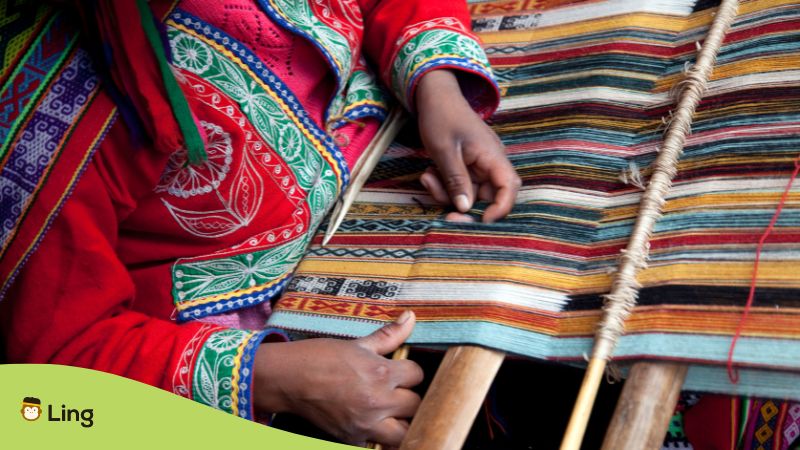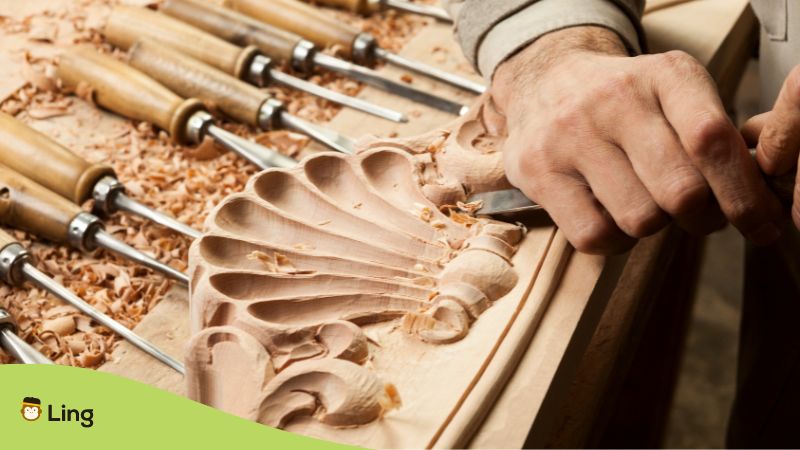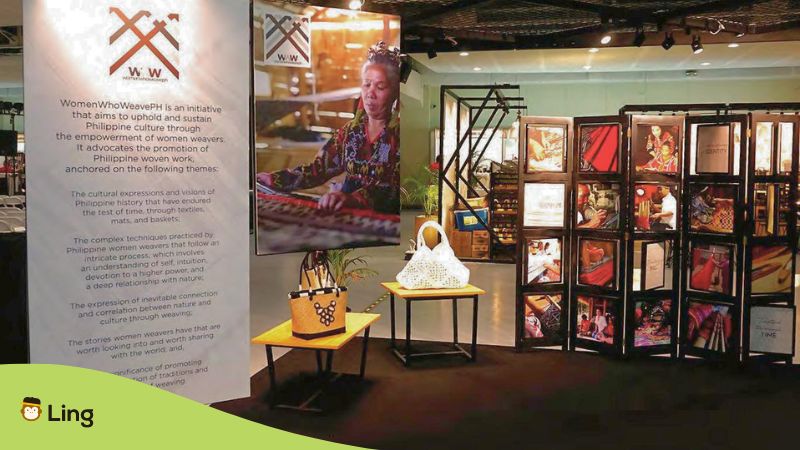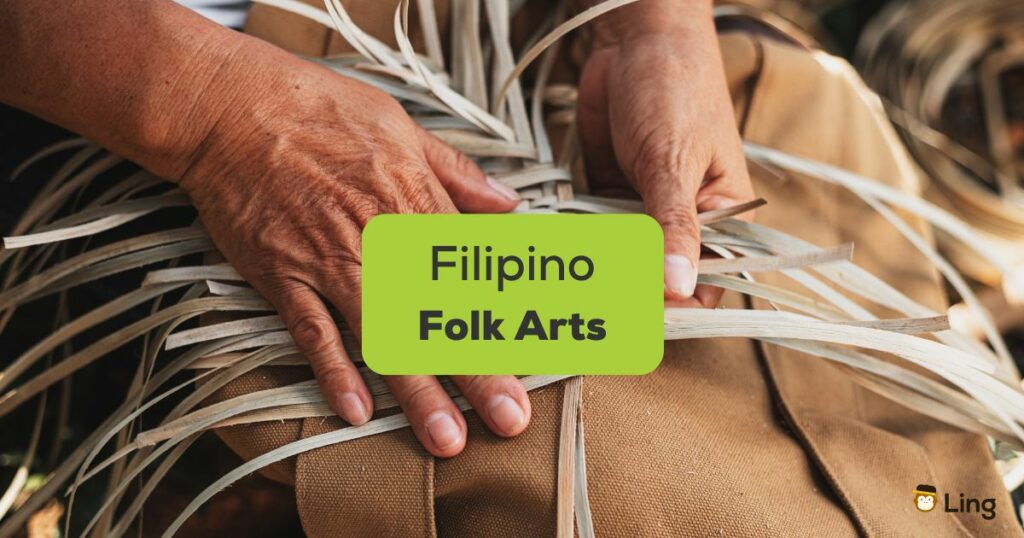Some might think Filipino folk arts are too boring and don’t make sense. No, they’re vibrant stories, secrets from our ancestors, all wrapped in eye-popping colors and mind-blowing patterns.
Growing up here in the Philippines, I’ve always been amazed by our Filipino artisans from different regions and ethnic groups. I’m one of the kids whose nose is always pressed against the glass, admiring the creativity. Ready to geek out on Philippine folk arts with me? Let’s go!
Table Of Contents
What Are Filipino Folk Arts?
First off, let’s define what we mean by “folk art.” Simply put, it’s the artistic creations made by ordinary people who haven’t had formal training in the arts. It’s raw, authentic, and straight from the heart—no pretensions or trend-following here.
And let me tell you, the different regions of the Philippines are overflowing with incredible folk art that showcases the creativity and ingenuity of our people. From folk painting to folk clay sculpture, from indigenous textiles to ornamental arts, we’ve got it all!
Now, you might be wondering, “What EXACTLY is Filipino folk art?” Well, to be honest, it’s a whole fiesta of creativity which includes different forms like:
| Type | Tagalog Term | Sound |
|---|---|---|
| Painting | Pagpipintura | |
| Woodcarving | Paguukit sa kahhoy | |
| Pottery | Pagpapalayok | |
| Weaving | Paghahabi | |
| Metalwork | Paggawa ng metal | |
| Accessory-making | Paggawa ng hiyas |
What Are Some Examples Of Philippine Folk Arts?
Ooh, now we’re getting to the juicy part—the actual folk arts themselves! There are actually too many to mention, like the Mangyan arts of Mindoro and the traditional art of tattooing, which Apo Whang-Od is known for being the last Mambabatok. But anyway, here are some of the most fascinating artistic traditions and traditional crafts from different parts of the Philippines.

The Woven Arts Of The Ilocanos
When it comes to Filipino folk arts, the Ilocanos of the north are definitely not to be missed! These people are known for their amazing weaving skills, especially when it comes to creating the famous inabel textiles.
Inabel Weaving
So, what’s inabel, you ask? It’s a handwoven cotton fabric made by Ilocano weavers using a traditional backstrap loom. Think stunning geometric patterns, each one more eye-catching than the last. There are a few different types of inabel designs, each with its own unique flair:
- Binakul: Blanket that will trick your eyes with its optical illusion patterns that look like whirlpools.
- Kutikut: Blanket with teeny-tiny geometric shapes, usually in bold red and black colors.
- Pinilian: Blanket that alternates between light and dark stripes, creating a striking contrast.
- Abel: General term that refers to all kinds of handwoven Ilocano textiles.
Ilocano weavers take their craft seriously. I mean, they even got special words for every little thing. Check out this handy table:
| Ilocano Term | English Meaning | Sound |
|---|---|---|
| Agabel | To weave | |
| Panagabel | The tradition of weaving | |
| Luplupugan | The spools for winding threads | |
| Kallawaidan | The part of the loom that adjusts thread tension |
Burnay Pottery: Ilocano Claywork
Burnay pottery, those terracotta jars and vessels, are not just for looks. Nope, they’re the real deal for storing and cooking Filipino food. Vigan, a UNESCO World Heritage Site up north, is famous for its old Spanish-style buildings and its thriving burnay industry.
These aren’t your average pots, either. They’re made by hand, using clay coils, and fired in open pits with rice husks. The result is a beautiful, rustic vessel that screams “Ilocos.”
And get this, some of the earliest porcelain found in the Philippines was also discovered in Ilocos, dating back to the 14th century before the Spanish and American influence. So yeah, these Ilocanos had been pottery pros way before the colonizers showed up!
The T’boli Dream Weavers Of Lake Sebu
Down south in Mindanao, you’ll find the T’boli people of Lake Sebu. These folks are weaving wizards, creating incredible textiles that are deeply connected to their spiritual beliefs.
Their most prized fabric is the t’nalak—made from abaca fibers and dyed in natural colors. It’s got these mind-blowing geometric patterns, but the designs don’t come from the weaver’s imagination. Nope, they believe the patterns are gifts from Fu Dalu, the spirit of the abaca plant, revealed in their dreams. That’s why they’re called “Dream Weavers”!
Watching them work is like witnessing magic. Using a backstrap loom, they meticulously weave each thread, bringing to life the intricate patterns they saw in their dreams. It’s a truly mesmerizing experience.
Some of the most notable motifs found in t’nalak include:
- Bulinglangit: Intricate spiral patterns that symbolize the heavens.
- Bankiring: Patterns that resemble frogs and represent good fortune.
- Niswalu: Diamond-shaped patterns that symbolize purity and fertility.

Paete: The Woodcarving Capital Of The Philippines
Our last stop is Paete, Laguna. This place is the “Philippines’ Carving Capital.” Here, generations of master carvers have honed their skills, turning wood into art and building a thriving industry in the process.
The History Of Paete Woodcarving
Paete’s woodcarving scene goes way back to the Spanish colonial days. Back then, friars hired local artisans to craft religious figures, and that skill just kept growing. Eventually, these talented self-taught artisans started carving everything from furniture and decorations to toys and souvenirs.
This Catholic influence definitely left its mark on Philippine art. The demand for religious icons led to new carving techniques and styles, blending European and indigenous elements.
But hold up, woodcarving wasn’t a Spanish invention. Our ancestors were already carving masterpieces long before the colonizers arrived. Remember the earliest known folk drawings like the Manunggul Jar from Palawan?
Paete Carving Techniques And Artistry
So what makes Paete carvings stand out? It’s the unbelievable detail and realism these Filipino folk artists achieve using just chisels, or pait in Tagalog. A Paete-carved saint, for instance, will have lifelike features, flowing clothes, and even hands and feet that look like they could move! Wanna know how they do it?
- Estofado: A technique that makes the wood look like expensive ivory or metal using gilding and paint.
- Encarna: Uses layers of translucent paint to create lifelike skin tones on wooden figures.
- Calado: A delicate carving technique that creates intricate, lace-like patterns on wood.
These Paete carvers don’t just pick up a chisel and wing it. They spend years learning their craft from their masters, honing their skills until they can create those breathtaking pieces.
It takes a deep understanding of the human form, a keen eye for detail, and a whole lotta artistic talent. Aside from the iconic religious figures, Paete artisans also create a wide variety of carved products like:
- Taka (papier-mache) masks and dolls.
- Furniture with nature-inspired carvings
- Intricately carved wooden toys, like the kalesa (horse carriage).
- Reliefs and plaques that depict historical and cultural scenes.
How Do Filipinos Keep Folk Arts Alive?
Many of these traditional arts are in danger of disappearing as lifestyles change and younger generations pursue other paths. That’s why several institutions are working hard to promote and preserve Filipino folk arts in different ways.

Cultural Fairs And Exhibitions
One notable effort is the DTI’s (Department of Trade and Industry) annual Sikat Pinoy National Arts and Crafts Fair in Manila. Here, artisans from all over the country showcase their traditional and contemporary creations.
Institutions like the Cultural Center of the Philippines and the National Museum also regularly hold exhibitions, workshops, and competitions. These events often feature:
- Notable folk clay sculpture.
- Indigenous Filipino textiles.
- Woodcarvings and other artistic creations that highlight the diversity and ingenuity of Filipino folk arts.
Literary And Art Criticism
Lately, there’s been a whole bunch of smart folks taking a fresh look at our folk arts. They’re digging into the deeper meanings, exploring the social, political, and historical stuff that makes these art forms so important.
Scholars have begun to study:
- Colonial literature written in Spanish and native languages.
- Non-colonial Filipino literature that challenges dominant narratives and reflects the experiences of marginalized groups.
- How Filipino folk performing arts have evolved over time in response to changing social conditions and artistic influences.
Contemporary Adaptations
And it’s not just the big institutions keeping folk arts alive. Plenty of awesome folks are finding creative ways to keep these traditions fresh and relevant.
- Fashion designers like Len Cabili and Marga Nograles are using traditional textiles in modern clothes.
- Rags2Riches helps folk artists reach more people and earn a living.
- Online platforms like Tala, Balay, and Likha connect artists with global buyers.
How Do You Say “Filipino Folk Arts” In The Tagalog Language?
You can say “Filipino folk arts” in Tagalog language as Sining Bayan ng Pilipinas. Here, sining means “arts,” bayan translates to “folk” or “town,” and ng Pilipinas means “of the Philippines.” The pronunciation is see-ning bah-yan nang pi-li-pi-nas.
Helpful Phrases To Use For Exploring Folk Arts In The Philippines
So, you want to connect with the locals and learn more about Filipino folk arts? Here are some phrases to help you ask the right questions and spark some engaging conversations:
Frequently Asked Questions About Filipino Folk Arts
Why Are Filipino Folk Arts Important?
Filipino folk arts are important because they showcase our ancestors’ way of life and beliefs, keeping our cultural heritage alive and giving us a sense of shared identity.
What Are The Traditional And Folk Arts?
Folk and traditional arts include various forms of expression like crafts, dance, music, oral traditions, and visual arts that are passed down through generations within a community.
Who Is The Father Of Folk Arts In The Philippines?
There isn’t a single “father” of Filipino folk arts as it’s a collective heritage of various indigenous groups. However, Guillermo Tolentino is considered the “Father of Philippine Arts” due to his significant contributions to sculpture.
Final Thoughts
So you see, Filipino folk arts aren’t just dusty relics from the past—they’re living, breathing proof of our ancestors’ creativity, resilience, and unique spirit. Let’s keep celebrating and supporting these traditions so they can continue to thrive and inspire us. After all, our folk arts are reflections of our vibrant culture, the Philippine history, and our boundless potential.


































































